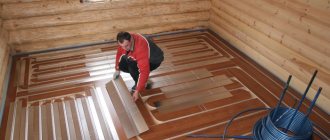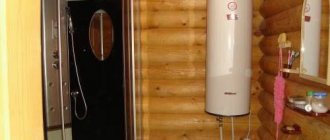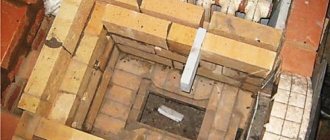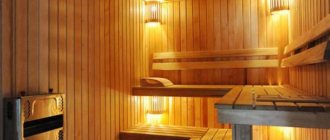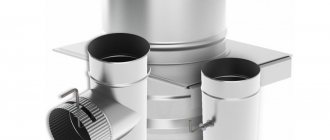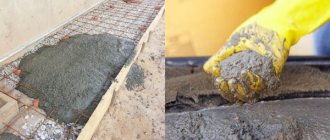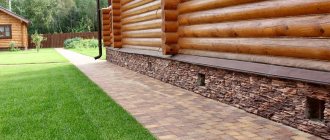How to cover the floor in a bathhouse? This is a very important issue, on which the durability of the entire structure and the comfort of bath procedures largely depend. The modern construction industry offers many different materials that can reliably serve as flooring. The difficulty is that bath conditions can be considered extreme, and therefore the choice of materials must be approached very seriously, taking into account their specifics.
The bath floor is under aggressive influence
Features of the problem
A classic Russian bath involves taking a bath procedure in an environment of saturated water vapor at temperatures up to 65 degrees. High humidity at this temperature promotes rotting of almost any material, especially wood. Of course, not all bathhouses are in the same conditions. A typical project involves dividing them into the following: steam room, dressing room, washing room, relaxation room. Requirements for flooring vary significantly depending on the room in which it is laid.
In general, the bath floor is under aggressive influence. Hot water mixed with detergents is poured onto it from above, water vapor condenses, creating a significant mechanical load, and all this at high temperatures. The influence from below is exerted by the soil: soil moisture, low temperatures in winter. As a result, increased demands are placed on the floor covering: water resistance, resistance to steam and chemical ingredients of detergents, resistance to high temperatures and temperature changes, mechanical strength (especially abrasion).
Floors in bathhouses are most often made of wood
. Attention! The most important thing: the coatings used under the specified conditions should not emit substances harmful to the human body.
No less important are the specific operational requirements: preventing bare wet feet from slipping, a warm surface, an aesthetic appearance, and the ability to easily clean from contamination.
Since ancient times, a wooden Russian bathhouse has been considered a classic option. Currently, the tradition is preserved, and floors are most often made of wood, which is facilitated by such important properties as high heat capacity, unique aroma and beautiful appearance. However, the use of such floors also creates a big problem: wood has low moisture resistance and is susceptible to active rotting in bath conditions, which requires protective measures to be taken. Concrete floors are also fairly common structures. They are also subject to destructive processes, and operating them without a floor covering is generally uncomfortable. The use of tiles for flooring is becoming increasingly popular.
Concrete floors are also fairly common structures.
Types of insulation
The competent choice of heat insulator for wooden and concrete floors deserves special attention. Due to the specific microclimate in the steam room, it is undesirable to use mineral insulation. This is due to several reasons:
- When wet, the thermal conductivity of the insulator increases;
- Damp mineral insulation is an ideal substrate for the development of pathogens: mold or mildew.
Expanded polystyrene is a non-hygroscopic insulation material that can be used to insulate both wooden and concrete bases
. Having decided to insulate floors with your own hands, it is advisable to choose the following heat insulators:
- Perlite is a lightweight material with minimal thermal conductivity, which is added to cement mortars to reduce the thermal conductivity of the screed;
- Expanded polystyrene is a non-hygroscopic insulation material that can be used to insulate both wooden and concrete bases;
- Polystyrene foam is a thermal insulating material that is similar in its technical characteristics to expanded polystyrene.
Despite the fact that there are functional differences between a sink and a steam room that affect the microclimate, it is advisable to treat the floors with special compounds after installation. This will prevent the materials from rotting and premature deformation.
Selection of materials for the base floor
A wooden floor in a bathhouse is usually made by laying boards on a system of joists. The most widely used types of wood are: spruce, pine, fir, larch. The use of oak on a bath floor is not recommended, as it becomes quite slippery at high humidity. The most water-resistant wood of these species is considered to be larch.
Floor design is important in the fight against rot. A real Russian bathhouse with pouring floors (photo 1) is a traditional system. The plank covering of such a floor is laid with a gap, which allows water to flow down freely. The second option is a leak-proof design. In it, on the contrary, water does not penetrate through the floor covering. It must flow along the floor surface into the sewer system or special waste collection basins.
Important! A prerequisite for arranging a wooden floor is impregnation of all elements with an antiseptic to prevent rotting. In addition, an important part of the structure is waterproofing and vapor barrier.
The concrete floor in the bathhouse ensures its high strength and durability. At the same time, the concrete base requires thermal insulation. When building a bathhouse, additives are added to the solution to increase moisture resistance. Floors of this type are made with a slope to direct wastewater towards the sewer drain.
Modern designs include tile and stone floors. Recently, the use of ceramic tiles and tiles made of artificial or natural stone has become increasingly popular. From a practical point of view, tiles have many advantages: high water resistance, mechanical abrasion resistance, durability. In particular, in a washing room, a tiled floor is simply irreplaceable.
The use of ceramic tiles and artificial or natural stone tiles is becoming increasingly popular
Installation technology for wooden leaky floors
When laying wooden floors, use the following technology:
- floor joists rest on the lower crown or are placed on individual supports in increments of 400-500 mm;
- A floorboard is laid on the joists. If the floor is not leaking, the boards are tightly fitted to each other, but if the floor is leaking, the installation is carried out while maintaining gaps of 3-5 mm;
- water from the bathhouse is removed through a drain well located under the water intake funnel in a non-leaky floor, or flows freely into the gaps between the boards if the coating is leaking.
Leaking floor diagram.
Arrangement of the floor in the steam room
The question of how to cover the floor of a bathhouse in a steam room is considered the most problematic. Here are the most extreme conditions, and the risk of releasing harmful substances increases significantly. Formaldehydes are the most dangerous, and therefore the use of products containing them is unacceptable. In principle, the floors in the steam room can be wooden, concrete or ceramic. Due to the complexity of the problem, some experts who are interested in how to cover wooden floors in a steam room recommend doing without coatings altogether, limiting themselves only to impregnating the wood.
Paint and varnish products can be used in a steam room, but with great restrictions. The safest way is to coat the boards with water-based paints. You can use dispersion acrylic paint. It dries quickly, and the resulting film does not interfere with air penetration. Oil and alkyd compounds cannot be used in the steam room.
Paint and varnish products can be used in a steam room, but with great restrictions
Photo
The final finish can be non-slip tiles
Drain
Floor with drain
Perlite
Wooden floor design with drain
Wooden floor with slope
Features of coatings in the washing area
How to cover the floor in a washing bath? A washing room is, of course, not a steam room, but the conditions for the floor here can hardly be called calm. There is no superheated steam or very high temperatures, but warm water is constantly flowing, which may contain impurities of soap and other detergents. Significant temperature changes occur in this room. In such conditions, it is especially important that the floor dries quickly and has a temperature that is comfortable for human feet.
In the washing department, ceramic tiles are most often used for flooring, which best meets all requirements. Often we have to decide the question of how to cover the wooden floor in a washing bath. Wood continues to be the main material for bathhouse construction, and therefore protecting it from rotting is very important. Here, as a rule, a poured floor is made, and protection can be provided by impregnation or paints and varnishes.
Wooden or concrete: which is better?
There is no clear answer to this question. Everyone chooses for themselves, taking into account preferences, as well as financial capabilities. Let's compare the main advantages and disadvantages of the two options.
| Concrete floor | Wooden floor | |
|
|
|
|
|
|
It is possible to combine a concrete floor with a wooden flooring, which allows you to get reliable support that is not prone to rotting, as well as a convenient floor covering that can be disassembled at any time and dried outside.
Features of coatings in other rooms
The dressing room is the first room into which a person enters when entering the bathhouse. There is no constantly flowing water, steam or high temperature. But here, as a rule, the firebox is located, which means, at a minimum, the area of the floor around it must have increased fire protection and thermal insulation. In addition, there is a significant temperature difference, since the dressing room on one side has access to the street, and on the other, the entrance to the steam room, and therefore in winter frosty air comes in from the street, and heated steam comes in from the inner doorway.
Floor in the waiting room
The question of what to cover the floor of a bathhouse in a changing room (dressing room) can be solved in different ways. The most common way is a wooden floor, the least applicable is ceramic tiles. The only area that requires special attention is the area in front of the firebox. Here, a metal sheet measuring at least 60x90 cm must be fixed to the floor.
How to cover the floor in the relaxation room of the bathhouse? In this room, aesthetic perception comes first. Everything should allow a person to relax after a bath procedure. The main condition: the floor must be warm enough to make it comfortable to walk on barefoot. Quite often, linoleum and carpet are used in the recreation room.
Floor in the rest room
How to choose an impregnating composition
Before installing the finishing coating, wooden floor elements in any bathhouse must be impregnated with an antiseptic to protect against microorganisms that cause rotting. The following compositions are considered the most popular antiseptics:
- Senezh Ecobio. The product is effective both outside the building and inside different rooms. It can be used during the construction of a bathhouse or during operation when signs of wood rotting are detected.
- Gladiator-1. The product does not emit harmful substances at high temperatures, which makes it possible to use it in a steam room. The composition has very high resistance to various chemically aggressive substances.
- Neomid. This composition can be safely used in a steam room; it does not have harmful ingredients that can be released at high temperatures. Before forming the final floor covering, this antiseptic is applied to the wooden parts in several layers. Almost any paint and varnish then adheres well to the treated wood.
Neomid can be safely used in a steam room
Concrete floor installation technology
To properly install concrete floors, use the following technology:
- the soil, which is the basis for the floor, is compacted;
- sand or fine gravel is poured over the compacted surface and compacted;
- then a concrete screed with a thickness of 100-150 mm is laid;
- vapor barrier, thermal insulation and waterproofing are sequentially laid on top of the screed;
- concrete is again laid to a height of 50 mm, after which a leveling screed made of cement-sand mortar is poured;
- The surface of the concrete floor can be sanded and treated with a primer. Tile is usually used as a finishing coating.
What varnishes are suitable for baths
Not all paint and varnish products are suitable for bath conditions, especially steam rooms. You can varnish the floor in a bathhouse only after making sure that it is harmless to humans at high temperatures and exposure to superheated steam. The varnish is applied after careful preparation of the wooden surface, including cleaning, sanding, and filling with a special solution. If traces of mold are found on the wood, these areas are treated with an antiseptic.
NEOMID Sauna is made on an acrylic base
You can make a floor in a Russian bathhouse using the following varnishes:
- NEOMID Sauna. This varnish is made on an acrylic base. Once dry, it forms a waterproof film with the ability to repel dirt. This film is quite elastic, resistant to moisture at high temperatures, and has high strength. The varnish is characterized by accelerated drying (25-35 minutes). As a rule, it is available in a translucent version, but if desired, it can easily be changed in color using dye.
- Atom-Color. This acrylic varnish is suitable for covering wooden floors in any bath room, including a steam room. There is one limitation - it must be applied at a temperature of at least 10 degrees.
Atom-Color is suitable for covering wooden floors in any bath room
Installation of floor joists
After installing the subfloor, we proceed to installing the floor joists. For floor joists, coniferous wood is best suited. The optimal dimensions of the timber are 150*150 mm. The bars must be sawn to the required size and treated with an antiseptic. The bars are laid on the subfloor perpendicular to the central, supporting beam. The distance between the joists must correspond to the width of the insulation that will be used to insulate the floor. A 150*50 mm board is nailed or screwed to the wall, perpendicular to the central beam and parallel to the floor joists, to secure the ends of the floor boards. We attach the logs themselves with long wood grouse to the central beam and, if there are supporting boards, then to them. For better fixation of the ends of the floor joists, we insert between them and fasten to the wall bars 150 * 50 mm long equal to the distance between the joists. The floor joists can also be secured using metal pins by drilling through the joists and the central support beam. This method will be more reliable, but not convenient in terms of installation; you will have to climb into a narrow underground.
All the work written above is performed for all types of floors, be it wood or concrete. Next, we will consider the design features of each floor separately.
The use of paints in bath conditions
Similar to varnishes, paints can also release harmful substances when heated, and therefore only certain paints and products can be used in bath conditions. For wood, this method of forming a finishing coating has been widely used since ancient times. So the easiest way to answer the question of how to cover a concrete floor in a bathhouse is traditionally: paint.
Water-based paint can be used in bath conditions
The following paints and products are used for bath floors:
1. Acrylic dispersion. The paint is classified as quick-drying. With its help, you can safely set up a steam room, and a wide range of colors makes it possible to decorate the relaxation room in any style. You can use this paint to solve the problem of how to cover the floor in the wash room in the bathhouse.
2. Oil paints. They have low resistance to high temperatures. When heated, the coating loses its shine and attractiveness. The oil variety is not recommended for floor installation in the steam room and washing room; it can only be used in the dressing room or rest room, if there is one.
3. Water-based paint. It has a natural base, which makes it possible to use it in bath conditions. If you decide to paint the floor in the steam room, then you can safely use this product. The paint does not have a long service life, but for 3-4 years it will properly perform its role.
4. Alkyd emulsions. They belong to economy class. At high temperatures they quickly fade, which limits their use in the steam room.
5. Silicate composition. This coating is liquid potassium glass, which provides good water resistance.
Liquid potassium glass
6. Sauna Natura. This protectant can be applied to untreated surfaces. The composition does not cover the structure of the wood, but rather emphasizes its texture.
7. Paraffin oil Supi Laudesuoja. The film formed by this composition has increased elasticity and softness, which makes walking barefoot comfortable. The oil can be applied to surfaces that previously had grease or oil stains.
Paraffin oil Supi Laudesuoya
Protecting the floor from moisture, mold and rot
When using a bathhouse, there is a high probability of mold fungi appearing on the floor and walls. Therefore, to prevent such processes, it is advisable to treat the floor covering before painting. The means used for this are different, because the material from which the floor in the washing compartment is made remains important. Protecting wood from the harmful effects of water and the further occurrence of microorganisms in it should significantly extend the service life of a wooden floor, improving and maintaining its performance properties.
The protective layer should be applied to the floor covering in the correct order. At the first stage, specialists clean the wood using a grinding machine. Then carefully remove all debris after sanding using a vacuum cleaner, broom and damp cloth. And at the final stage it is necessary to impregnate the wood using special means.
Depending on the basic properties, impregnations can be divided into several types:
Floor waterproofing scheme
To apply impregnation in the washing area, use brushes (for hard-to-reach places) and rollers (for the main area). To enhance the effect, experts recommend applying several layers of impregnation of different types. But in this case, it will be necessary to maintain a certain time interval between treatments, which is indicated in the manufacturer’s instructions. And only after the boards have completely dried can you proceed to painting. Popular and effective means of treating wooden floors are such as Neomid 2000, Ecosept 200 and Senezh Sauna.
Harmful bacteria can affect tiles, laminate and even linoleum. If the floor covering is not treated with a special product in time, the owners will have to face serious problems. And this may further threaten the health of those who use the premises.
Protecting the floor from mold and mildew using traditional methods is considered effective. To do this, during processing, agents such as vinegar, ammonia, hydrogen peroxide and boric acid are used. After completing the surface treatment of the floor covering, you should ventilate the room well, completely getting rid of the specific odor.
You can also use store-bought products to treat surfaces in the sink. These include powders, sprays or ready-made solutions and mixtures. But you should be careful when processing. It is best to use gloves during the procedure to keep the skin of your hands intact, and a respirator to protect the respiratory organs. Effective means are bleach, antiseptics “Antifungal”, “Izotsid”, “Mil Kill”, Dali, as well as copper sulfate.
Features of heated floors
When using a bathhouse, any person wants to feel comfortable. A warm floor in a Russian bath is one of the ways to increase the comfort of the bath procedure. Of course, it is not needed in a steam room, where the steam perfectly warms up a wooden or concrete floor, but in a washroom or rest room, providing the ability to feel the heat with your bare feet will certainly add to the pleasure.
There are several known ways to arrange such a floor. The following technologies can be used in the bathhouse: water or electric heating, as well as installation of an infrared film floor.
Electric heated floor in the bathhouse
In the first case, a system of pipes is passed under the floor covering through which heated water circulates. Heating of the coolant can be ensured by a sauna stove by passing a collector inside it.
On a note! Electric underfloor heating is provided using a special cable, which has high electrical resistance and heats up when current passes.
The most modern method is the installation of infrared mats. They are produced in the form of film in rolls. They do not require a large floor thickness, and can be installed in any area that requires additional heating. When electric current is applied to such elements, infrared rays are generated, which heat the air space in the room.
In a Russian bathhouse, the issue of floor covering is quite acute, since most often the bathhouse is built of wood. High humidity and temperature cause active rotting of wood, and concrete cannot resist aggressive influences. The correct solution to the question of how to cover a bath floor allows you to ensure a long service life.
Auxiliary premises
Linoleum in the dressing room
In rooms with low humidity levels and relatively low temperatures, it is allowed to use laminate and linoleum that are prohibited for steam rooms. In the dressing room, such a covering is laid on top of a special flooring, which makes it possible to dry the floors. When using such a base, the flooring is double, consisting of rough and finishing flooring.
Expert advice
When working on the floor, you must adhere to the following recommendations:
- the optimal height of the floor base above the ground is considered to be a level exceeding this mark by at least 30 cm;
- for the manufacture of natural wood floors, edged or tongue-and-groove boards with a thickness of about 25–35 mm are selected;
- Laying logs on brick columns in such structures is mandatory.
The procedure for arranging floor coverings in a bathhouse made in the old Russian style is essentially no different from the procedures described above (taking into account the fact that the floors in the steam room can even be earthen). Before preparing them, you will need to perform the following operations:
- Along the perimeter of the base, at a distance of about 50 cm from the foundation, soil is first selected (to a depth of approximately 45–50 cm).
- The resulting area is filled to the required level with a mixture of fine gravel and sand, and then thoroughly compacted.
- The boards are laid directly onto the prepared base, which is quite consistent with floors made using ancient methods.
Recommended reading:
- Do-it-yourself warm water floor in an apartment
- How to choose electric heated floors for laminate
